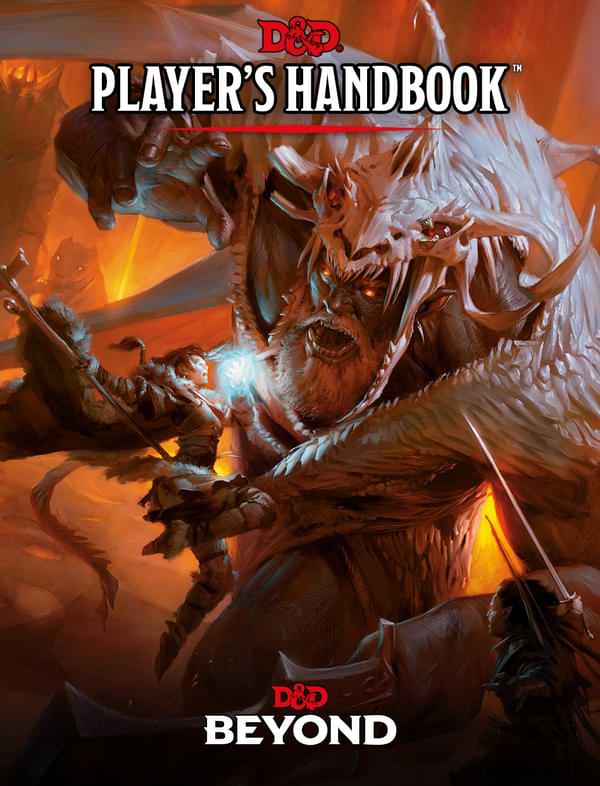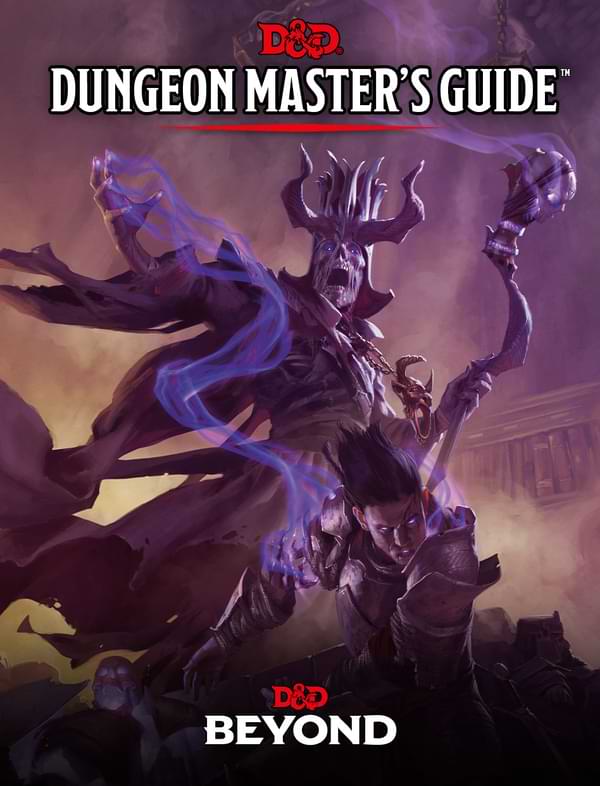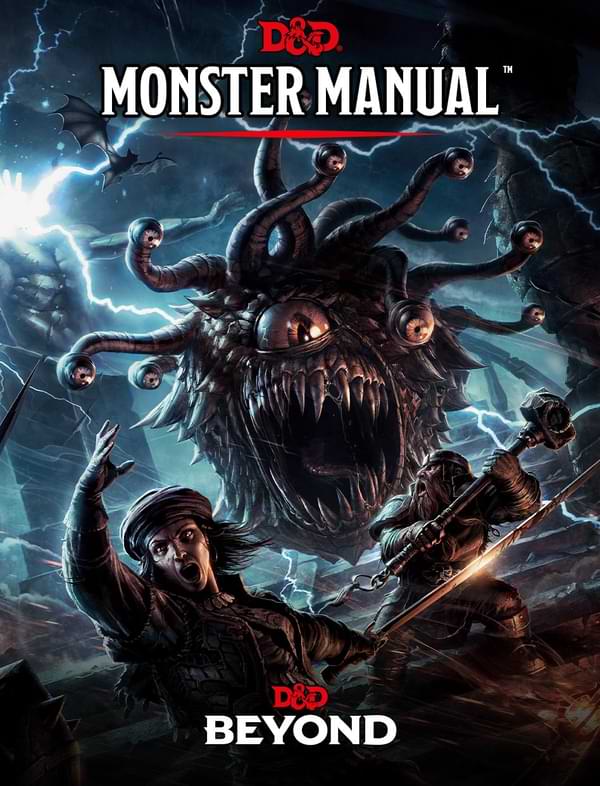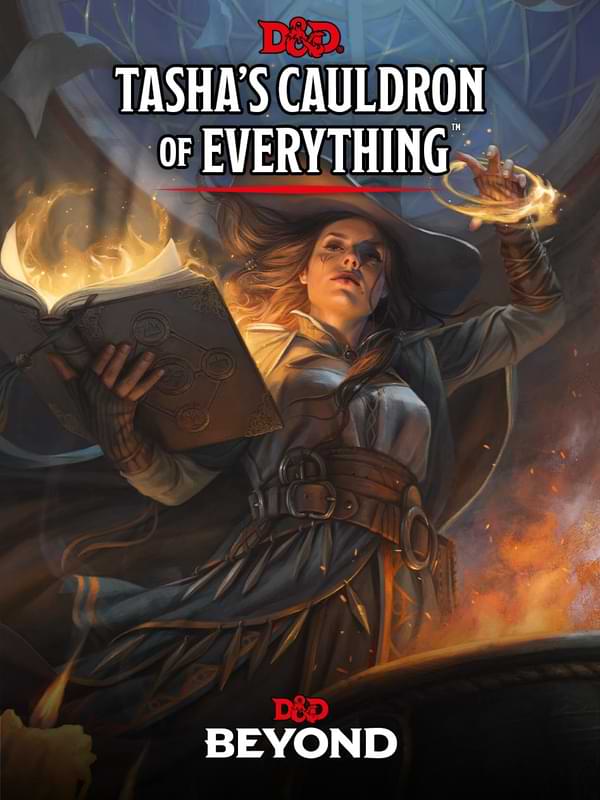D&D Beyond offers the Basic Rules of fifth-edition Dungeons & Dragons for free. These rules help you explore the game and get a feel for the different races, classes, and monsters without any investment.
But if you’re interested in seeing the breadth of character creation options available in the books — or you want to pick up tools to run your own game — we recommend the following D&D books for beginners:
Share your books with other players
D&D Beyond users with a Master-tier subscription can freely share books they’ve purchased with players in their campaigns.
To do so, create a campaign. Then, navigate to your campaign’s page and select “Enable Content Sharing.” Players who join your campaign will automatically have access to your purchased books on D&D Beyond. You can share content with up to 12 players in each of five campaigns.
Player’s Handbook
 The Player’s Handbook is the quintessential book for new players. It includes everything you need to create characters, including the core classes, races, backgrounds, and spells. You’ll also find the rules for multiclassing and feats, which are optional rules that can further customize your characters:
The Player’s Handbook is the quintessential book for new players. It includes everything you need to create characters, including the core classes, races, backgrounds, and spells. You’ll also find the rules for multiclassing and feats, which are optional rules that can further customize your characters:
- Multiclassing. You can gain levels in two or more classes, allowing you to mix their abilities. A lot of abilities are front loaded in classes and can result in powerful and flavorful combinations. A wizard who takes two levels in fighter can use the Action Surge feature to cast two spells in a turn, for example. But you might simply decide that your barbarian character has taken an interest in yodeling and should pick up a few levels of bard.
- Feats. Whenever a player character receives an Ability Score Improvement, they could pick up a feat to specialize in an area beyond what their class provides or to supplement their strengths. For example, a barbarian could choose Great Weapon Master to help deal damage instead of only acting as a shield; a wizard could choose Magic Initiate to gain two cantrips and a 1st-level spell.
The appendices of the Player’s Handbook expand on the lore behind D&D. You’ll find information on the gods, multiverse, and creatures you might encounter.
Dungeon Master's Guide
 A Dungeon Master runs more than a dungeon — they create and manage the whole world that the party interacts with. From voicing and puppeteering creatures to moaning like the wind, the Dungeon Master has a lot to do. The Dungeon Master’s Guide offers everything you need to run your own game.
A Dungeon Master runs more than a dungeon — they create and manage the whole world that the party interacts with. From voicing and puppeteering creatures to moaning like the wind, the Dungeon Master has a lot to do. The Dungeon Master’s Guide offers everything you need to run your own game.
You’ll learn about the different styles of play in D&D and how to create worlds. The book also contains magic items to shower on your player characters and all the nitty-gritty rules you need to run encounters, downtime activities, and make exploration exciting.
Here are more examples of what you’ll find in the book:
- Discover new settings: Want to take your player characters to the unpredictable Plane of Faerie? You’ll learn about fey crossings and the time-warping effects of the Feywild. Want to explore the Shadowfell, where undead creatures can hunt your player characters? You’ll find details in this book.
- Create villains: If you want to tell the story of a new crime boss who has overthrown The Xanathar Guild, the book has rollable tables to help you create a villain and determine their motivations.
- Designing adventures: Dreaming up a plot for a session or entire campaign can be challenging. This book offers guidance on structuring an adventure and has rollable tables for determining the quest the party receives, how you might introduce it, the climax of the adventure, and complications the party will encounter.
Looking for an adventure?
If you're a new Dungeon Master, learning the rules of the game on top of writing and running your own campaign can be a challenge. You might also find that building your own world is easier when you have published material to reference. If you're looking for recommendations on an adventure to run, check out our primer of the best adventures for new Dungeon Masters.
Monster Manual
 The Monster Manual provides the stat blocks on about 500 monsters drawn from mythologies across the world. If you want classical monsters like werewolves and vampires, you’ve got ‘em. If you want fantastical aberrations like floating eyeballs and space lizards, you’ve got ‘em. If you want elemental entities like sentient flames — that’s right, you’ve got ‘em.
The Monster Manual provides the stat blocks on about 500 monsters drawn from mythologies across the world. If you want classical monsters like werewolves and vampires, you’ve got ‘em. If you want fantastical aberrations like floating eyeballs and space lizards, you’ve got ‘em. If you want elemental entities like sentient flames — that’s right, you’ve got ‘em.
Dungeon Masters don’t have to use a monster as a great, big, physical adversary. Here are some other ways you might use the monsters found in the Monster Manual:
- An unexpected ally. Creatures could give advice or blessings. If the party is working to save a forest, a unicorn might appear to protect them from dangers. In dungeons, flumphs could foreshadow what’s ahead by changing colors to depict whether they’re amused, scared, or angry.
- To offer needed exposition. A guardian naga could be seeking to retrieve a magical relic that the party is after and offer a short history lesson on the item.
- Serve as an adventure hook. A sprite caught in a traveling circus might offer to draw a treasure map if you help them escape.
- Provide moral quandaries. Will player characters make a deal with a green hag for the greater good? Will they put innocents in danger to capture or kill a vile creature?
- Be the base for a homebrew creation. D&D Beyond lets you take a published creature and use it as a base for your homebrew creations.
Explore free creatures in the Basic Rules
The Basic Rules on D&D Beyond offer free creatures for you to use in your fifth-edition D&D game. Click here to begin browsing creatures. If you want to see creatures found only in the Basic Rules, select “Show Advanced Filters” and then fill in the “Sources” section with “Basic Rules.”
Tasha's Cauldron of Everything
 Tasha herself is a chaotic non-player character, and her book introduces a slew of new character options that will have players drooling. Tasha’s Cauldron of Everything includes new subclasses, spells, feats, and magic items, as well as the custom lineage option, which lets you customize your starting race or create a new one.
Tasha herself is a chaotic non-player character, and her book introduces a slew of new character options that will have players drooling. Tasha’s Cauldron of Everything includes new subclasses, spells, feats, and magic items, as well as the custom lineage option, which lets you customize your starting race or create a new one.
Every class receives at least one brand-new subclass in this book. These include the Armorer artificer, Way of the Astral Self monk, Rune Knight fighter, and Twilight Domain cleric. Subclasses that were previously printed across several different publications are reprinted here, as well.
Aside from new spells, you’ll also find that some existing spells have been added to new classes. A lot of the new feats in the book can also be taken by just about any character, expanding your ability to customize your character.
Dungeon Masters will enjoy the 47 new magic items presented in Tasha’s Cauldron of Everything. Magic tattoos, in particular, can be a fun addition to your campaign, while items like the bloodwell vial can help players get more mileage out of class abilities.
But some of the most important content for Dungeon Masters is found in the latter parts of the book. There, you’ll find the long-awaited session zero blueprint — the meeting that the Dungeon Master and players should have before the start of a campaign. It discusses how everyone at the table can communicate their wants and needs and create a safe and inviting space.
Which D&D books should you buy first?
If you’re a new player to Dungeons & Dragons, the Player’s Handbook is a great place to start. Once you’re familiar with the system — or if you’re just raring for more character creation options — Tasha’s Cauldron of Everything is a great purchase for your second book. In addition to new content, it consolidates character options found in other books like Eberron: Rising From the Last War, which first introduced the artificer class.
For Dungeon Masters, the Player’s Handbook and the Dungeon Master’s Guide are must-haves for understanding the rules of the game and running it. Although the Monster Manual is an important addition to your collection, if you need to hold off on the purchase, you could make do with the free creatures offered in the Basic Rules. When you’re ready to level up your and your player’s game experience, snag a copy of Tasha’s Cauldron of Everything.
Jenn Jones (@jennesai) is a writer, hiker, cosplayer, and avid consumer of board games. She lives in Charlotte with way too many paint supplies, never enough dice, and one cat.








-
View User Profile
-
Send Message
Posted Jun 30, 2021Will the books be free to the shared people
-
View User Profile
-
Send Message
Posted Jun 30, 2021I believe what happens is that the content of the books will be available to the shared players for accessing classes, races, spells, weapons, items, etc. through their character sheets. They will not, unless I'm missing it, have access to the actual digital books. I'm sure of the former, I could be wrong on the latter though.
-
View User Profile
-
Send Message
Posted Jun 30, 2021This is definitely a big help to new players
3rd
-
View User Profile
-
Send Message
Posted Jun 30, 2021I wish they made those books free so beginners do not have to pay a lot of money to get into something that they may not like
but I like the article
-
View User Profile
-
Send Message
Posted Jun 30, 2021They have access to everything. I'm the person who buys the content in my group, and everyone at my table has access to literally everything since I own the content and have a master tier subscription, including the digital books. They're on the honor system in terms of staying out of the adventures. That being said, you can choose which books specifically to share so if you're in a module, you can block sharing of it, and then for the sake of magic items that are specific to that module, add it for them.
-
View User Profile
-
Send Message
Posted Jun 30, 2021The Starter Kit or Essentials Kit has everything physical that beginners need to play many sessions, through level 5, for $25 or less. And, as the article notes, you can download the Basic Rules (or look at them here on D&D Beyond) for free! There's enough information in them to play or run a game for months, which should give beginners a pretty good idea of whether they want to play more.
Buying these books should happen when you're ready to commit to playing and want more options. Unless you're running pre-written campaigns, they could be the only books you ever need to buy for years of play! (And if you're just a player, not a Dungeon Master, you don't need the Dungeon Master's Guide or the Monster Manual.)
I do think the article might have mentioned the Starter Kit and Essentials Kit as good places to start. I think it's also worth noting that many people see Xanathar's Guide to Everything being of similar value to Tasha's.
-
View User Profile
-
Send Message
Posted Jun 30, 2021Go to your profile page (which you can do by clicking on your name here) and click the "Edit Profile" button. Look under the "Avatars" tab.
For general questions like this, instead of just posting in random comments sections, you might want to go to the Forums... maybe General Discussion?
-
View User Profile
-
Send Message
Posted Jun 30, 2021Oof, I would have definitely recommended Xanathar's over Tasha's. Yes, Tasha's is newer, and I get that the article is probably a not-exactly-subtle attempt to push it, but... the newness is a bad thing, not a good thing, in this context. It's too much extra customization, too fast, for beginners IMO.
It also doesn't help that some of Tasha's still has yet to be implemented properly on the site.
-
View User Profile
-
Send Message
Posted Jun 30, 2021Yeah, Xanathar’s is definitely much better then Tasha’s for new players. Xanathar’s has some more subclasses, a few handy tables to help beginner players with a backstory (it’s really useful for experienced players too), handy DM stuff such as better encounter building stuff, random encounters tables, and magic item tables, and some more niche stuff, such as rules for downtime and tools. Tasha’s has far too many customization options (as RodtheBard said) that will probably overwhelm new players, weirder subclasses, and much more stuff that is niche at best and definitely not for new players.
-
View User Profile
-
Send Message
Posted Jun 30, 2021Plus Xanathar's commentary is hillarious.
-
View User Profile
-
Send Message
Posted Jun 30, 2021Definitely disagree with the Tasha's Cauldron of Everything pick! It's just a way to recommend new books to players instead of old. Here are my recommendations for new non-DM players:
For DMs:
-
View User Profile
-
Send Message
Posted Jun 30, 2021So true
-
View User Profile
-
Send Message
Posted Jun 30, 2021PLEASE DON'T POST HATE COMMENTS IF YOU SEE THIS!! PLEASE!!
I know that ads are hard, but know that it all goes to support a platform we love. Just let it happen, it'll pass, and we'll get good content articles soon enough. Please.
Thanks for letting me rant a bit there. I just want to support this platform as much as I can, and I don't like seeing people complain about all this stuff. If people'd just wait a little and be patient, they'll see what they want.
Edit: Haha, guess I was hasty. People seem to be doing great. Little embarrassed, but the warning STILL STANDS! :)
-
View User Profile
-
Send Message
Posted Jul 1, 2021Gotta agree.
-
View User Profile
-
Send Message
Posted Jul 1, 2021This list is absolutely designed for DungeonMasters rather than players in every respect.
A beginning player should have PHB, XGE, for rules cleanup, VGM for more races, TCoE for rules additions. That is the beginning player book list.
MM is a DM-needed book.
DMG is only sorta kinda barely needed. (We mostly just need the last couple magic items not in the basic rules)
-
View User Profile
-
Send Message
Posted Jul 1, 2021Poor Xanathar's Guide to Everything. Xanthar feels so left out. He's going to go on a Disintegration Eye Ray binge now.
-
View User Profile
-
Send Message
Posted Jul 1, 2021Yep. So long as they are active in a campaign you've created, they can view all of your purchased material for free if you have content sharing on.
-
View User Profile
-
Send Message
Posted Jul 1, 2021If we're genuinely trying to offer useful comments for new players, we should probably avoid using acronyms they are unlikely to know.
Also, with all due respect, I think it's unlikely new players are going to want to buy seven or eleven books. Beyond the Player's Handbook (the obvious choice as THE most important book to purchase for 5e once you're ready to go beyond the Basic Rules and/or boxed starter set(s)), we should probably keep our suggestions trim and provide justification.
Your suggestion about setting sourcebooks is interesting and a good point. I think the Forgotten Realms is sufficiently "generic fantasy" that people can get by without the Sword Coast Adventurer's Guide; but committing to a long campaign in Eberron or Ravinica or whatever probably merits a sourcebook!
...
Anyway, to weigh in on Xanathar's versus Tasha's: as I said in a previous comment, I think they have equal value. It depends what you want most.
Xanathar's Guide To Everything has more beginner-friendly material: fantastic subclasses, (mostly, in my opinion) more interesting & useful spells, and some very helpful rules.
Tasha's Cauldron of Everything, on the other hand... whatever one's opinion on it might be, it's clear that "Lineages" are going to be the way of the future for D&D, so getting used to them might be more useful; and although more effort, they give players a lot more freedom to realize an unusual character they envision. I also think Sidekicks are an insanely useful tool for smaller groups. Also, I think, better spells for "magic swordsman" (sub)classes like the "Eldritch Knight" Fighter. (Yeah, I know most of those good cantrips appeared in The Sword Coast Adventurer's Guide first, but Tasha's is a more useful collection to most players, without another big wall of text explaining the pros and cons of yet another book...)
I don't think either is as important as the other books on the list. But I'd recommend Xanathar's as a "second round purchase" for most people, who feel they just some great ideas and options to spice things up; but I'd specifically recommend Tasha's first to groups that want to allow more customization, or need to add "sidekick" NPC's to round out a small party.
-
View User Profile
-
Send Message
Posted Jul 1, 2021See my comments as noted above in blue Comic Sans font.
-
View User Profile
-
Send Message
Posted Jul 1, 2021To be fair, they did say it's also for if "you want to to pick up tools to run your own game."